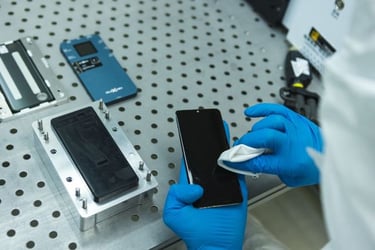Are you seeing a higher demand for more affordable tech from your customers? Maybe they’re also seeking more sustainable options.
Refurbished products satisfy both of these criteria and offer additional benefits.
With over a decade of experience working with many customers and their technology products, Ingram Micro Lifecycle has built up a market-leading technical know-how and insight. We offer returns management, refurbishment and repair programs worldwide for various enterprises and high-end consumer electronics customers.
In this latest piece, we aim to help you better understand the advantages of switching from supplying only new technology, to supplementing your offering with refurbished tech.
Your refurbishment questions answered
How will refurbished devices impact the satisfaction of my customers?
As mentioned previously, there is a noticeable market demand for refurbished devices. 1 in 4 mobile phones sold in the UK in 2023 were second-hand or refurbished. The global market for refurbished electronics is estimated to hit $94.10 billion in 2030, rising from $48.29 billion in 2023.
Ensuring you satisfy their needs will keep them coming back to your business.
The devices you supply must meet the expectations of your customers. This includes the clarity of descriptions of the device quality and completing any repairs and refurbishments to a high standard.
If there are issues with the quality of the device, such as it fails to meet performance expectations, then satisfaction will be impacted. You must have confidence in the quality of the refurbished devices.
Make sure the supplier you use adheres to high standards and can deliver the make/models your customers are seeking promptly. Having no stock of in-demand products will make your customers shop elsewhere.
Can I lower the average cost of devices?
Following a strict process to maintain and repair devices within your inventory is more affordable than buying brand-new stock. Parts impacted by general wear and tear/age of the device can be replaced to uplift the product value.
These worn components don’t have to be replaced with brand-new parts. Instead, a repair partner can use good-quality donor parts from similar devices. A partner that has comprehensive repair solutions will be able to replace common parts, like batteries, very easily, and will options for more technical replacements, like LCD screens. This lowers the average cost of the device.
Looking for partners with robust repair and refurbishment solutions will boost your yield of refurbished goods.
How can I recover the highest value on my refurbished devices?
As mentioned above, repair and refurbishment processes will recover value in a product by uplifting the grade. Cosmetic polishing will restore the aesthetic appeal of the product and also increase its value.
These processes restore how attractive the product is in terms of functionality, quality, and looks. Increased desirability = increased value.
How can I get refurbished devices?
Refurbished devices stem from unwanted, previously owned tech. The call is on consumers to trade in or sell their unwanted tech so these can go through repair and refurbishment products to give them a new life on the secondary market.
Not only do consumers get some cash back in exchange for their used tech, but they’re doing some good for the planet too. Ensuring the tech is re-used avoids the risk that it goes into landfill or other form of informal disposal, and becomes e-waste.
Source these devices through your B2C trade-in scheme and find a partner to extend product lifecycles. Alternatives are auction sites, resellers, eCommerce platforms, and B2B buyback programs (buying used tech in bulk).
Depending on your business, you may have a tech returns management program that you can tap into. Process these to repair and refurbish ready for re-use.
What are the data risks for used devices?
Data-bearing devices must be compliantly data-wiped to comply with data protection legislation. Look for ISO 27001 certified businesses to partner with, and those with accreditations for stringent data handling processes. Look for partners with accreditations for stringent data handling processes, such as ISO 27001, and use industry-trusted software like Blancco.
These processes must provide an audit trail and certificates of data wiping so, should any issues arise from data leaks, you can provide evidence that suitable avoidance measures were taken.
Take every precaution to ensure that the devices you pass on to your customers contain no residual data. Failing to do so breaches data protection laws, leading to reputational damage and heavy fines.
What technology can be refurbished?
There are lots of different products that can be repaired and refurbished, ready for re-use including:
- Vacuums
- Coffee machines
- Hair dryers/stylers
- Smartphones
- Gaming consoles
- Tablets
- Laptops
- Routers
- Set-top boxes
- TVs
- Air fryers
- Ear pods
- Smartwatches
The economic viability of the repair can be a barrier. Component access can be another issue. For example, where manufacturers use glue instead of screws. This can make a product impossible to repair as components cannot be removed without causing additional damage.
While some approaches quickly and cost-effectively manufacture a product, there can be knock-on effects down the supply chain for commercial viability to repair. This then runs a risk of the technology becoming waste or recycled as the lifecycle can’t be extended.
What are the benefits of offering refurbished devices?
These are a more environmentally-friendly option than the purchase of brand-new products. By extending the lifecycle of a product that's already in the market, you avoid consuming the raw materials associated with manufacturing. The used product avoids becoming e-waste which risks damaging the environment. Refurbished products are associated with reduced carbon emissions compared to new products.
For consumers, refurbished products are more affordable. For some, this is a more desirable option as they can open up a product range that was previously unobtainable. For businesses, a new market segment can purchase from you.
They’re also cheaper for you to procure compared to brand-new products.
These products can also be more accessible. The supply chain doesn’t typically rely on international shipments, leading to quicker turnaround times and lower carbon emissions.
As time continues, processing and handling of used goods is improving which means refurbished products are of a higher quality now than ever before. You can be more confident, using the right partners and processes, that your customers are getting a high-quality product, often to like-new standards.
What is the refurbishment process?
First for any used, second-hand, or returned electronic devices ahead of reselling is a thorough data wiping process. This step is crucial to ensure all residual data is completely erased, meeting data protection regulations.
Following data wiping, each device is carefully inspected to determine the extent of repair and refurbishment required. Devices found to be beyond economical repair are disassembled, with salvageable parts repurposed for the remanufacturing of similar devices, or recycled. Most refurbishment needs are cosmetic, such as polishing out scratches. Some devices may require replacement parts like LCD screens or batteries.
If appropriate, the operating system is updated to ensure the device operates at peak performance.
Then the product is repackaged with all necessary accessories. This varies from product to product and may include peripherals such as power cables, charging leads, and other accessories.
Once restored to a like-new, near-original condition, the product is remarketed and sold through eCommerce channels or to buyers, ready for its next user.
What are the risks of counterfeit goods/parts?
Purchasing from less reputable suppliers can result in lower-quality parts and subpar repairs on refurbished devices. For example, batteries might perform poorly with shorter lifespans, or phones could have screen burn, affecting usability. These issues can lead to an increase in returns, as the devices fail to meet your customers' expectations.
As customer satisfaction with your brand declines, frustration grows, and they may choose to shop elsewhere in the future, favoring competitors, and causing your market share to decrease.
Effective screening processes will identify counterfeit parts. These are components that aren't OEM-approved and are typically of inferior quality.
Your chosen partner refurbishment partner must be able to detect counterfeit parts. The partner should be OEM accredited, which provides access to and use only genuine parts for repairs.
How does refurbished technology support a circular economy?
A circular economy seeks to limit the volume of manufactured products that are only used once and then wasted. Repair and refurbishment processes ensure that a product avoids becoming e-waste and is instead suitable for reuse. The lifecycle of the original product is extended as often as feasibly possible to ensure the materials consumed have maximized use. This limits the volume of raw materials needed to produce a brand-new replacement and is a much more sustainable option.
Switching to a refurbished supply
The market demand for refurbished goods is evident. Opting to source and supply these to your customers not only benefits them but your business too through financial and sustainability gains.
Technology is always advancing and so are the processing capabilities around them. Ingram Micro Lifecycle is always seeking innovative ways to cost-effectively and sustainably solve repair and refurbishment conundrums.
Reach out to us today to discuss how we can turn your returns into valuable assets, or to learn more about our technical repair and refurbishment processes.
Related articles:
- 7 reasons why consumers are switching from new to refurbished devices
- 5 sourcing pitfalls to avoid when stocking refurbished electronics
- 4 ways a circular economy has influenced device ownership
- 9 technology industry & reverse logistics certifications
- How to repair damaged smartphone screens: smashed & delaminated screens
- How smartphone screen repair promotes sustainability & circularity













